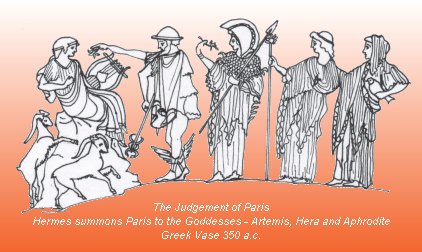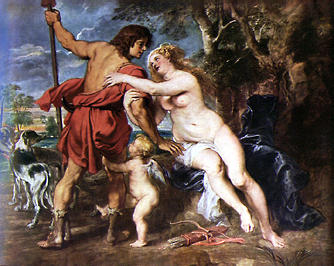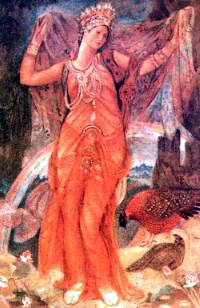

The Venus Transit 2004
... Extended InfoSheet D9
Venus in Mythology
As Venus is the brightest object in the sky after the Sun and the Moon, it is the most frequently seen of all the planets. In Siberia it was the only planet to have a name and was called Cholbon. It was identified with both the Morning Star and the Evening Star and sometimes any other bright planet which happened to be visible such as Jupiter or Mars. So it is clear that Venus has been known since prehistoric times.
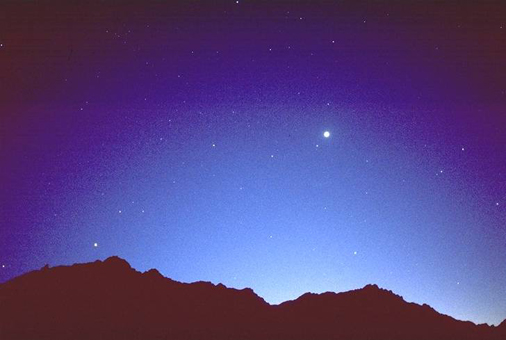
Venus as a bright star shining in the sky (credit: British Astronomical Association)
Venus and Aphrodite
Venus is named after the Roman goddess of love and peace. To the Greeks this was Aphrodite, to the Egyptians the goddess Isis and to the Phoenicians the goddess Astrate. She was associated with the metal copper (from Cyprus, which was Aphrodite's birthplace), a flattish triangle, the number five, the colour blue, and the day Friday. The Saxons used the name of their fertility goddess, Fria, which led to the English name of Friday, whereas the French name Vendredi indicates its Greek-Latin origin.
Venus/Aphrodite is known as the Daughter of Heaven and Sea, the child of Uranus and Gaia. Also she is said to be a daughter of Zeus or to have sprung from the foam of the sea.
The birth of Venus
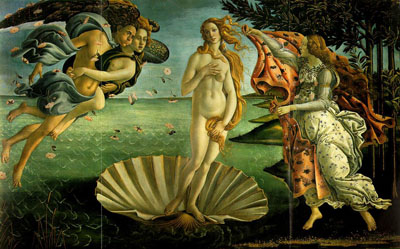
Birth of Venus by Sandro Botticelli (1485-86) (credit: Uffizi Gallery, Florence)
There are two versions of her birth. In the first version told by Hesiod, she was older than the Olympians. When the Titan Cronus severed his father's (Uranus) genitals and flung them into the sea, the blood and semen caused foam to gather and float across the sea to the island of Cyprus. There Aphrodite rose out of the sea from the foam (hence her name came from the word aphros, which means foam). She had experienced no infancy or childhood; she came into existence as a fully grown, young woman. The Clam Shell Version.
In the second version told by Homer, she was known as the daughter of Zeus and the ocean nymph Dione. The Cherubs Version. She was married to Hephaestus (Vulcan) and bore children but she did not attend to her domestic duties. In fact, she concentrated almost completely on extramarital affairs with gods and mortals. Her many lovers include Aries, the God of War - this affair was the most notorious of all and the longest - and the handsome Adonis. She was the mother of Eros (Cupid), Deimos (Fair), Phobos (Panic) and Harmonia, wife of Cadmus. One of her mortal sons was Aeneas, by her lover Anchises, King of Dardania. Anchises was crippled by a thunderbolt from Zeus, when he revealed that he had made love to the goddess.
Aphrodite and the Trojan War
Venus/Aphrodite was indirectly the cause of the Trojan War. It started with a contest. The aim was to name the most beautiful goddess. The choice was narrowed down to three: Juno, Pallas Athena and Aphrodite. Godfather Zeus was chosen to decide and wisely declined, suggesting they ask a young shepherd, Paris, who he assured them, would be a fair judge. Paris was not asked to look at the goddesses, but to choose the fairest by judging which of their gifts he would accept. Juno offered to make him the ruler of Europe and Asia; Pallas Athena assured him he would lead the Trojans to victory over the Greeks; and Aphrodite offered him the fairest woman in the world. He gave the golden apple of choice to Aphrodite and the goddess led him to Helen of Troy, the wife of Menelaus. Her abduction was the cause of the Trojan War.
Aphrodite and Adonis
Another important figure in the mythology of Aphrodite is Adonis. Smyrna, the daughter of King Cinyras of Cyprus, was rumoured to be more beautiful than Aphrodite/Venus. Cinyras's wife bragged of her daughters beauty and aroused the goddess' vengeful nature. Venus caused a spell to fall on Smyrna who then fell in love with her own father, went to him while he was in a drunken stupor and became pregnant by him. When Cinyras found out what happened, he pursued Smyrna to kill her and as he raised his sword to strike her, Aphrodite turned her into a myrrh tree. The tree was sliced in two and out fell Adonis.
Adonis was taken to Persephone (Queen of the Dead) to be raised and it turned out that both goddesses, Persephone and Aphrodite, fell in love with him and wanted him for themselves. When the Muses were asked to resolve the situation they declared that Adonis should spend one third of his time with Persephone, one third of his time with Aphrodite and one third of his time alone hunting in the hills.
The dishonest side of Aphrodite emerged and she used her power to get Adonis to fall in love with her and to stay with her rather than abide by the decision. In anger, Persephone told Aries/Mars and he disguised himself as a wild boar and challenged Adonis on the slopes of Mount Lebanon, where Adonis was gored to death in Aphrodite's sight. Aphrodite, still unwilling to let go of him, begged Zeus to intervene. He did and Adonis was allowed to spend half of his time above ground and the other half in the underworld.
Ishtar
This story is very similar to the Story of the Sumerian goddess Ishtar. The Sumerians from whom Greek astronomy derived many of its ideas saw this planet as Inanna, also Ishtar or Eshtar. It was the morning star and the goddess of love - particularly sexual and erotic love, and also of war and battles. She had wings, rode on a lion and was armed with bow and arrows. She is usually depicted near the sun god, since she is always near the Sun. She had a sister - her evening counterpart who was the guardian of the gateway to the world of the dead.
She descended into the underworld to find the soul of her dead lover, Tammuz. As she journeys through the underworld, she is stripped of her glory by the guardians of Hell. When she comes before the Queen of the Dead, she is hung on a meat hook and left for dead. Eventually she is rescued by the will of the gods and made the Queen of Heaven.
Other cultures
To the Chinese, the planet was the Great White One and was associated with the element metal (more specifically gold), the westerly direction, and the same day in the week. The idea of the seven day week and the planets ruling hours and days may have been derived from India.
Astronomers in Central America had a similar concept. To the Maya, Venus was the god of war, and it was believed to beam down evil rays bringing death and destruction. Maya astronomers therefore made very careful records of the planet and a ritual calendar was based on it.
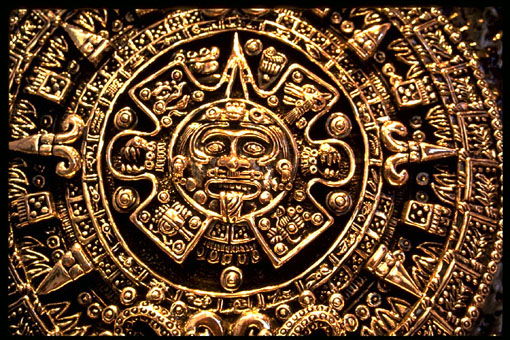
The Aztec calendar (credit: Corel Corporation)
Go to the corresponding Brief InfoSheet
Back to the List of Extended InfoSheets.

